Highcliffe Castle Golf Club ... taking the biscuit!

As with many organisations in the small Dorset town of Highcliffe (correctly Highcliffe-on-Sea), the golf club has a close association with Highcliffe Castle, originally a grand house built by former Prime Minister John Stuart, The Third Earl of Bute, to "command the fairest outlook in England".
When Sir Charles Stuart's son returned from his first appointment as Ambassador in Paris in 1824, he adapted the old High Cliff House, which had been virtually demolished, into what is now known as Highcliffe Castle.
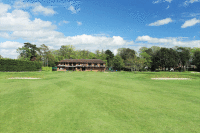
That kind of endeavour can be recognised in Highcliffe Castle Golf Club's greenkeeping team, whether repairing phallic symbols carved into the greens by drunken teenage holidaymakers or embarking on an ambitious tree management plan.
The layout at Highcliffe Castle is rather unusual in that it comprises ten par 4s and eight par 3s, with a par of 64. Total length is just 4,836 yards and the total acreage is tiny, at around fifty acres. That said, the course record is 62 and its intriguing layout can catch out even the most experienced golfer.

"My first job in the industry, when I was sixteen, was at a golf driving range doing odd jobs, and it was here that I developed a liking for golf. I also spent two years working for Wiltshire Direct Services as a groundsman and, latterly, as a twenty-one year old chargehand with them."
Mike has three staff to support him. Dave Baugh is the first assistant, who has been with club for seven months, and the team is completed by assistant greenkeepers Dan Yeo (thirteen years service) and Sam Day (approaching nine years).
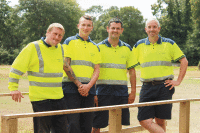
"Being a small course, presentation is very important, as everything is always on show," notes Mike.
Leaving aside all things 'phallic' for the moment, Mike is keen to talk about the tree management plan that he has put into place.
"The course has some very old and large trees, and these really come into play. All the trees are subject to Tree Preservation Orders, and they are a very emotive subject with most of the membership. Some of the tree lines are also important with regards to health and safety, such as the one alongside the 14th hole, which protects the main road and members of the public from miss-hit golf balls."
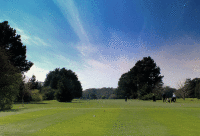
"The club then decided to employ the services of an arboriculturalist to assess all the trees. His very detailed report has a felling list and a replanting schedule."
"During the storms at the beginning of 2014, we lost twelve large trees that really impacted on several of the holes," continues Mike.
"The planting list is quite extensive, with seventy-eight semi-mature trees to be purchased. The membership are doing a 'sponsor a tree' scheme, which has gone very well, and we are hoping to purchase and plant all the trees this coming autumn."
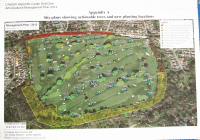
The club celebrated its centenary in 2013 and Mike is keen to point out that they have a very loyal membership, with family links that can be traced back to the original members.
"I meet with the secretary daily, and we liaise about what competitions or societies are upcoming and what available dates we have for course works. If we are doing anything that will disrupt play, then I post notices around the clubhouse. I have a monthly greens committee meeting and we discuss all matters about the course. It is here that I answer all members' questions and, if requested, I will produce a course newsletter. I'm always out on the course, and I get on well with most members, so I'm happy to discuss anything with them as we are doing it.
I have never done a course walk, but would be happy to do so if anyone showed an interest in one."
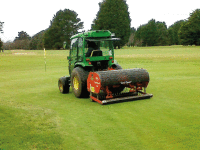
"We are very fortunate that every Tuesday is quiet, so we try and do any disruptive work then. As we only have 7000m2 of greens, anything we do can be normally done in a day and, with good brushes and rollers, the greens are all back in play immediately after we have finished."
"We also have very little in the way of thatch on the greens, so we do not hollow core or heavily scarify them. We do solid tine and dress quite often though. We aim for around 120 tonnes of sand dressing a year, and we solid tine, using different tines, monthly through the year. We also sarrel roll when we feel the need, and we slit tine the whole course through the winter periods."
"We don't verti-cut greens on a regular basis either; we just do it when we feel the need is there. This is mainly when the bents are getting a bit straggly at the start of the year. We have a Campey triplex brush which we use every time we cut and I find that this eliminates the need to verti-cut as often. The fairways are scarified twice a year using a Sisis Veemo, and we will scarify the greens using our Thatchaway units, if needed. The tees, approaches and fairways are hollow cored once a year."
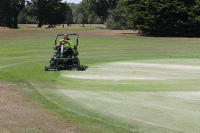
"Greens speed through the summer is around 9 to 10 on the stimp. I don't check speed too often; we carry out good practices and then they are what they are. You can see and hear if a green is any good. I watch a lot of putts as well and listen to members' comments. If the feedback is not great, then we assess what we are doing and alter it. The agronomist's test results show precisely what is going on with the greens, and the results are always, well usually, favourable!"
"I don't follow any sort of prepared nutrition plan, I just use what I know works for us. This year we are using Farmura Premium N and Premium K, Porthcawl, GBR Acti-fe and a 5:5:10 and 3:0:3 turf hardener. Tees and approaches have a slow release feed at the start of the year. When this peters out, they are then fed with Porthcawl and low rates of NK. I aim for anything under 100kg n/annum on greens. Primo Maxx and wetting agents are used on all areas."
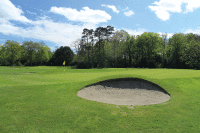
"I don't overseed greens at all, just work with what I have. We use a 100% dwarf rye on tees, which is applied through divoting. We now use a fescue mix on fairways, which is applied mostly through divoting, but we will overseed any thin areas."
"During the last eight years, we have carried out an awful lot of aeration work on the fairways. When I first started here, there was a lot of thatch in them, and any rain that fell could not penetrate it. I started in the summer with brown fairways and, when the rain did come, they turned black and slimy. Any more than about 6 or 7mm of rain would result in flooding!"

"The first items of machinery I purchased here were a Sisis Megaslit and a Sisis Veemo. The first autumn we scarified, hollow cored, overseeded with dwarf rye/fescue and topdressed with green waste compost.
Through the winter, we verti-drained and slit tined. The following year, we had another drought - sixteen weeks with no rain - and things turned brown again. We repeated the same maintenance that year, in year three we went dry again, but we maintained grass cover, and, when the rain came, they greened up much more quickly."
"We still carry a lot of aeration, we hollow core annually, scarify twice a year, verti-drain three times a year and slit tine three or four times.
Any weak areas are overseeded with fescue and dressed with a 70/30 divot mix. We use wetting agent, organic liquid fertilisers, water soluble fertilisers and Primo Maxx on all fairways."
Mike goes on to explain that pests and diseases are treated as needed. "We spray around five times a year for fusarium. I don't use fungicides for red thread or anthracnose, I just give it a little feed and grow it out."
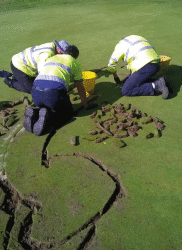
"The only pests we spray for are worms and leather jackets. Carbendazim is used for worms, and now, of course, we have nothing for leatherjackets. The last couple of years have been really bad for them, so I'm a bit anxious to see what happens this winter now that product has been withdrawn. The best advice I have had so far is to try and encourage starlings!"
"The biggest animal problem we have is with young humans, who come through the course late at night after drinking on the beach. They then consider it okay to carve phallic symbols into the greens and pinch flags and bunker rakes! If I were to catch them at it, I would think a stern telling off might do the trick," suggests Mike, somewhat tongue in cheek!
"We used to use temporary greens for frost, but we stopped four years ago. I've never liked using temporary greens for frost, and the members do nothing but moan about it. So, I informed the greens committee that we would have a trial winter of not coming off main greens for frost. I was an instant hero! We had an average winter and, come the spring, there was absolutely no negative outcome."
Mike explains that the soil is generally quite sandy, with a subsoil of gravel. "We do have quite a bit of clay in some areas and this causes our drainage problems. But having a subsoil of gravel means that draining these areas doesn't cause us too many problems."
"The greens and tees are push up. A couple of the raised greens were built up on piles of hogging, or any other old rubbish they could find. This doesn't help with drainage, but there is a good depth of rootzone, so the quality of the greens is good."
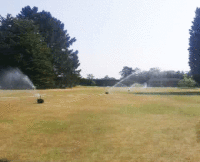
"We have an old, but serviceable irrigation system. It's twenty-one years old now, but still does what I ask it to. We have carried out a lot of head changes and are currently replacing the valves as we do suffer with puddling around some of the heads. We have irrigation to the greens, tees and approaches. We use mobile sprinklers on the fairways when it gets really dry, only having small fairways (7ha in total) makes this possible."
"We really suffer with dry spells, being right on the south coast, and we have our own little microclimate. It can be chucking it down ten minutes up the road, and we will not have had a drop."
End of season renovations consist of aeration, aeration and aeration! The whole course is aerated from October onwards and this keeps two men busy virtually up until Christmas. "We do suffer with wear areas, so the worst of them are turfed," Mike explains.

"This year, we are planning to carry out more drainage work and, of course, the tree planting programme."
"Any large works, such as the ditches, have to be priced and put in the budget. All of the smaller jobs come out of the main budget. We put aside £10k for 'other work', which includes all winter work and running repairs to the course. Most of the work we do is more labour intensive than materials expensive. As we do 99% of works ourselves, we don't have the costly expense of outside contractors."
"The only extra help we have needed recently was with the digging of the two drainage ditches, basically because we didn't have a digger big enough. All the final shaping and finishing off was done by ourselves."

"We always have a list of jobs on the go, so if we cannot carry out one because of inclement weather, we switch to the other. Idle hands mean long boring days, so we always have something to do."
Mike is clearly very happy at Highcliffe Castle Golf Club. He has a strong work ethic that is popular with the members and he is supported well by his staff. But he is aware that all is not so rosy across the golf industry. "From my point of view, everything is okay, but the fact that so many clubs have either had to lay off staff or close altogether in recent years has been terrible for all involved. However, when you look in the job sections on various websites, the number of vacancies seems to be on the increase, which is encouraging."
"I can only speak from my personal experiences, and I think I've always been treated fairly at the four clubs I have been at. Golfers do have a tendency to be very critical of 'their' courses and, if something isn't to their liking, they are quick to moan. I don't see any way of changing that; you just have to become thick-skinned and get on with it."
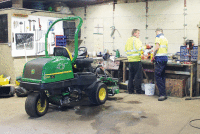
John Deere D2500 triple mowers x 3
John Deere 2653 surrounds mower
John Deere 1445 rough mower
Jacobsen Fairway 250
John Deere E Gator
John Deere 4410 tractor
John Deere 955 tractor with back hoe
Kioti DK551c tractor
John Deere 220 pedestrian greens mowers x 3
Flymo hover mowers x 2
Stihl strimmers x 4
Stihl backpack blowers x 2
Stihl hedge cutters x 2
Stihl chainsaws x 2
John Deere Aercore 1500
Charterhouse Verti-Drain 7316
Sisis Megaslit
Sisis Maxislit
Sisis Veemo
Hardi sprayer
Earthquake aerator
Stihl leaf blower
Wessex trailers x 2
Charterhouse topdresser with brushes
Greentek attachments - verticutter, vibro roller, sarrel roller, scarifier
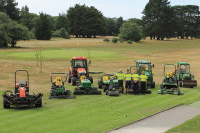
The main mowing machines are on a ten year replacement schedule. This is not set in stone and, if they need replacing in eight years or so, then they are, and, if at ten years old, they are still serviceable then we will keep them on. This works well, but I really have to keep an eye on things as I don't want to ask for too much in any one year.
I will always try to buy ex-demo or very good second hand machines, if possible, as the savings can be quite large. If, for example, we were to replace a greens mower, then we would use the new list price as a guide. I would then hunt for the best deal I can find. As the club have budgeted for the full list price, then anything I can save can be used for buying extra bits of kit. I usually have around £25k per year for machinery.
I always go to New Forest Farm Machinery first. I get on well with them and the John Deere dealer back up is exceptional. The last major piece of equipment we purchased was the Jacobsen F250, which came form EG Coles. This machine was their ex-demo.
I've used John Deere, Toro and Jacobsen machinery. They all have their good and bad points, and I don't really have a preference.
We hire in a big verti-drain and operator from John Pierson for three days in October to aerate the fairways. Our machine has maximum tine size of ¾", whereas Piersons can use a 1" tine with a huge amount of heave.
Our Charterhouse topdresser is a fantastic piece of machinery and, if I ever leave, it's coming with me! It's a trailed dual spinner machine. We can topdress all the greens in around three hours, putting on anything from around 6-10 tonnes per application."
